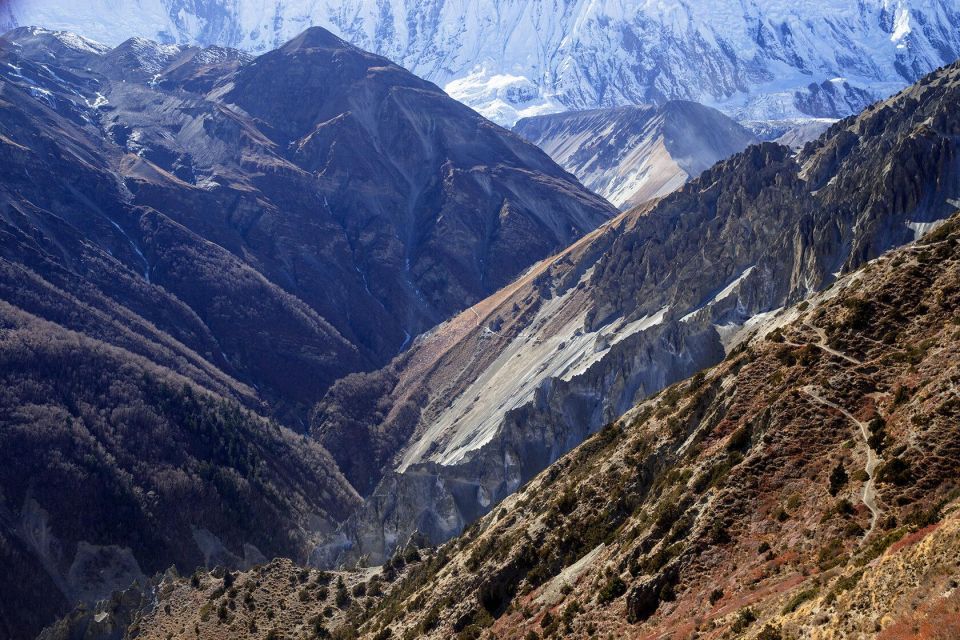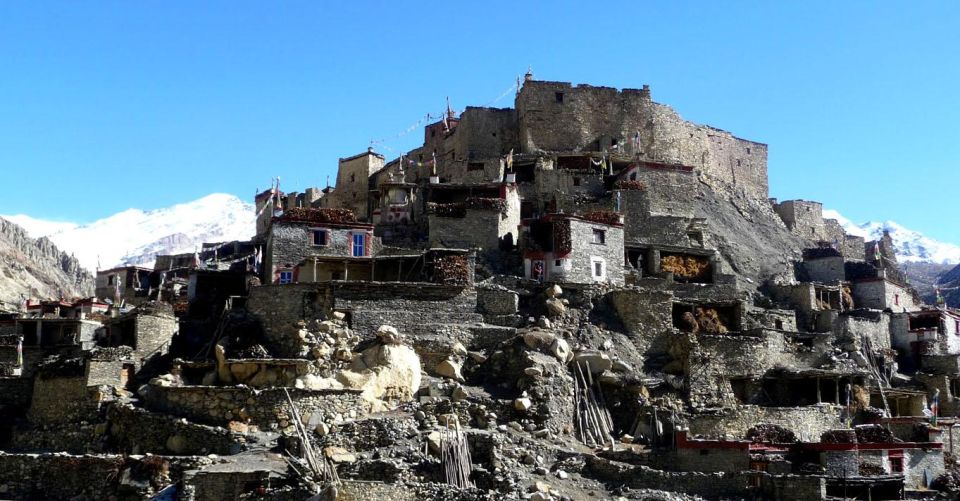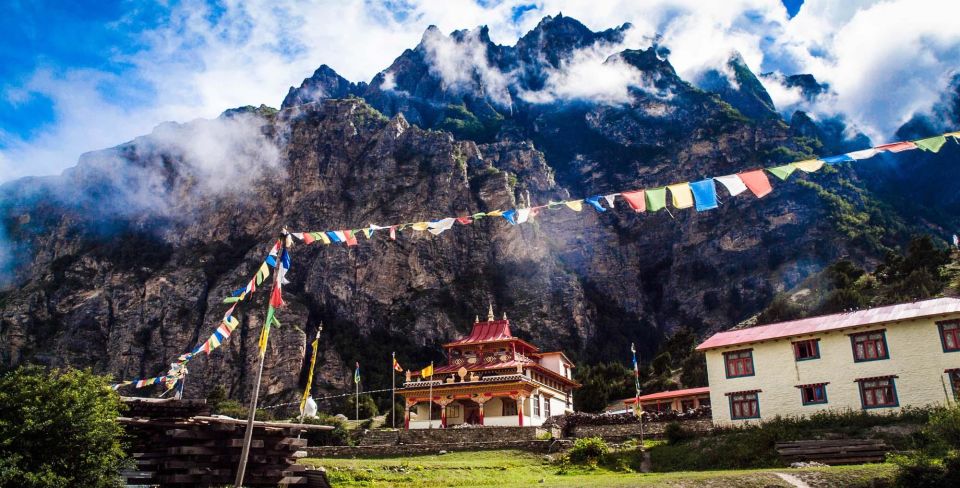The Nar Phu Valley Trek presents a unique opportunity for trekkers to enjoy the striking landscapes and rich culture of the Annapurna region. This 17-day journey challenges adventurers with high passes and rewards them with breathtaking vistas of the Annapurna and Manaslu ranges. Along the way, trekkers experience local Tibetan hospitality and cuisine, adding depth to their adventure. However, understanding the trek’s physical requirements and logistics is crucial for a successful experience. What else should trekkers know before embarking on this remarkable journey?
Key Points

- The Nar Phu Valley Trek spans 17 days, starting from Chamje and includes high passes like Phu and Thorung La.
- Best trekking seasons are March to May and September to November for optimal weather conditions and breathtaking scenery.
- Trekkers require a strong physical fitness level, with prior multi-day trekking experience recommended for endurance and safety.
- Essential permits include the Nar Phu Valley Restricted Area Permit and Annapurna Conservation Area Permit, arranged through trekking agencies.
- The trek offers rich cultural experiences, stunning landscapes, and opportunities to spot rare wildlife like snow leopards.
Overview of Nar Phu Valley

Nestled within the breathtaking Annapurna Conservation Area, Nar Phu Valley offers trekkers a unique blend of stunning landscapes and rich cultural experiences.
This remote valley, often overlooked by travelers, features challenging high passes like the Thurung La, Phu, and Kangla Pass.
Trekkers can enjoy the local Tibetan culture, experiencing warm hospitality and savoring traditional cuisine.
The trek provides breathtaking views of majestic peaks, including Mount Annapurna and the Manaslu Himalayan range.
Wildlife enthusiasts may even spot elusive snow leopards in their natural habitat.
With its unspoiled beauty and authentic cultural encounters, Nar Phu Valley promises an unforgettable adventure for those seeking a truly unique trekking experience in Nepal.
Detailed Trek Itinerary
The detailed trek itinerary for the Nar Phu Valley Trek outlines a challenging yet rewarding journey through stunning landscapes and rich cultural encounters over 17 days. Starting from Chamje, trekkers will traverse diverse terrains, reaching the breathtaking high passes and captivating villages.
| Day | Activity |
|---|---|
| Day 1 | Drive to Chamje |
| Day 8 | Trek via Phu Pass |
| Day 14 | Trek to Muktinath via Thorung La Pass (5416m) |
Each day presents unique experiences, from exploring the ancient village of Phu to marveling at the majestic Annapurna range. This itinerary not only highlights the natural beauty but also offers a deep dive into the local culture, ensuring an unforgettable adventure.
Physical Fitness Requirements

Trekking the Nar Phu Valley demands strong physical fitness and endurance due to its challenging high passes and varied terrain.
Hikers should possess a solid base of cardiovascular fitness, as the trek involves long days of walking at high altitudes.
Prior experience with multi-day treks is beneficial, as it helps build stamina and prepares the body for the rigors ahead.
Strength training, focusing on the legs and core, will enhance stability and reduce the risk of injury.
It’s recommended that trekkers engage in regular aerobic exercises, such as running or cycling, and practice hiking on inclines to simulate trail conditions.
Proper acclimatization is also crucial, allowing the body to adjust to thinner air and altitude changes effectively.
Best Trekking Seasons
Optimal trekking seasons for the Nar Phu Valley are from March to May and September to November, when the weather is stable and the trails are more accessible.
During these months, trekkers enjoy clear skies, moderate temperatures, and breathtaking views of the surrounding peaks.
March to May marks the spring season, where wildflowers bloom and the landscape comes alive.
In contrast, the autumn months of September to November offer crisp air and vibrant foliage, creating a stunning backdrop for the trek.
Trekkers should avoid the extreme cold of December to January and the heavy monsoon rains from June to August, which can lead to slippery trails and challenging conditions.
Planning a trek during these optimal months ensures a more enjoyable experience.
Necessary Permits
What permits are essential for navigating the Nar Phu Valley Trek?
Trekking in this stunning region requires two vital permits: the Nar Phu Valley Restricted Area Permit and the Annapurna Conservation Area Permit. The Restricted Area Permit ensures that trekkers can explore this less-traveled area, preserving its unique culture and environment.
Meanwhile, the Annapurna Conservation Area Permit allows access to the broader Annapurna region, promoting sustainable tourism.
Obtaining these permits is straightforward and typically arranged through trekking agencies. It’s crucial to secure these documents before embarking on the trek, as authorities strictly monitor compliance.
With the right permits in hand, trekkers can fully enjoy the breathtaking beauty and rich traditions of the Nar Phu Valley.
Trek Inclusions
The Nar Phu Valley Trek includes essential amenities such as three daily meals, comfortable accommodation, and a licensed guide to enhance the trekking experience. Trekking in this stunning region, trekkers benefit from the following inclusions:
| Inclusion | Details | Notes |
|---|---|---|
| Meals | Three meals daily (Breakfast, Lunch, Dinner) | Vegetarian options available |
| Accommodation | Comfortable lodgings during the trek | Varies by location |
| Guide | Experienced, English-speaking government licensed | Ensures safety and knowledge |
| Permits | Annapurna Conservation and restricted area permits | Included in package |
These essentials ensure trekkers have a memorable journey, focused on exploring the breathtaking landscapes and rich culture of Nar Phu Valley.
Local Culture and Wildlife
Exploring the Nar Phu Valley reveals a vibrant tapestry of local culture and unique wildlife, offering trekkers an immersive experience in this remote corner of Nepal.
The region’s rich Tibetan heritage shines through in its monasteries, traditional festivals, and warm hospitality from local communities. Trekkers can engage with residents, learn about their customs, and savor authentic Tibetan cuisine.
Wildlife enthusiasts will appreciate the chance to spot rare species such as snow leopards and Himalayan tahr, which roam the rugged terrain. The diverse ecosystem, characterized by stunning landscapes, further enhances the trekking experience, making it not only a physical journey but also a cultural and ecological exploration.
This blend of culture and wildlife captivates every adventurer’s heart.
Booking and Cancellation Policies
Trekkers can easily secure their spot for the Nar Phu Valley Trek by making a reservation, with the added benefit of a flexible cancellation policy that allows for a full refund up to 24 hours in advance. This policy provides peace of mind, accommodating any last-minute changes in plans.
Plus, there’s a ‘reserve now, pay later’ option, making it convenient for those who wish to commit without immediate payment.
Trekkers should be aware that securing necessary permits is part of the booking process, ensuring a smooth adventure. By understanding these policies, trekkers can confidently plan their journey, knowing they’ve options if circumstances change.
Thus, booking the Nar Phu Valley Trek becomes a straightforward and stress-free experience.
Frequently Asked Questions
What Is the Altitude of Nar Phu Valley Trek?
The altitude of this trek varies significantly, reaching heights over 5,400 meters at its highest passes. Proper acclimatization’s crucial to ensure trekkers adapt well and enjoy the stunning views throughout their journey.
Are There Any Age Restrictions for Participants?
There aren’t strict age restrictions for participants, but it’s essential that individuals assess their physical fitness and experience. Many trekkers aged 12 to 65 enjoy the journey, adapting itineraries as necessary for comfort and safety.
How Do I Get to the Starting Point in Chamje?
To reach Chamje, one can take a bus or private vehicle from Kathmandu to Besisahar, then continue by local jeep or bus to Chamje. It’s a scenic journey, offering beautiful views along the way.
What Type of Accommodation Can I Expect During the Trek?
During the trek, travelers can expect basic yet comfortable accommodations, typically in teahouses or lodges. These provide essential amenities and local cuisine, creating an authentic experience that immerses them in the region’s culture.
Is It Safe to Trek Solo in Nar Phu Valley?
Trekking solo isn’t always safe, especially in remote areas. It’s essential to assess trail conditions, carry proper gear, and inform someone of your plans. Joining guided groups often provides additional safety and support.
Not for you? Here's more of our most recent tour reviews happening neaby
- 14 Days Jomsom Muktinath Trek
- 8 Day Kathmandu,Pokhara, Muktinath (Lower Mustang) Jeep Tour
- From Kathmandu: Budget 9 Day Annapurna Circuit Trek
- Pokhara: 9-Day Annapurna Circuit Trek
- Lower Mustang & Muktinath MotorBike Tour – 9 Days
- From Kathmandu Budget: 12 Day Annapurna Circuit Trek
- Nepal Odyssey: A Spiritual Journey – Kathmandu to Muktinath
- Kathmandu: 12 Day Upper Mustang & Lower Mustang 4W Jeep Tour
- From Kathmandu: Annapurna Circuit Trek 15 Days
- From Pokhara: 6 Day Private Upper Mustang 4W Jeep Tour
- From Kathmandu: 18 Days Upper Mustang Trek
- From Pokhara: 5 Day Private Guided Upper Mustang Jeep Tour
- 10 Day Kathmandu,Pokhara,Lower Mustang 4W Jeep Tour
- Pokhara: 4 Day Lower Mustang,Dhumba Lake,Muktinath Jeep Tour
Recap
The Nar Phu Valley Trek promises an exceptional blend of adventure and culture.
Trekkers are sure to be captivated by the region’s stunning landscapes, rich Tibetan heritage, and diverse wildlife.
With careful planning, including attention to physical fitness and permits, adventurers can fully embrace this unique experience.
Whether savoring authentic cuisine or conquering high passes, the trek is a rewarding journey that leaves lasting memories for all who venture into this remarkable part of the Annapurna region.
